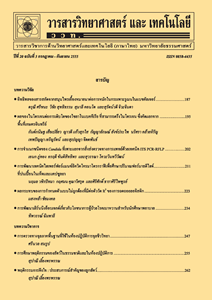แบบจำลองการพยากรณ์ราคามันสำปะหลังโดยใช้โครงข่ายประสาทเทียมแบบหลายชั้น
Main Article Content
Abstract
บทคัดย่อ
งานวิจัยนี้นำเสนอแบบจำลองการพยากรณ์ราคามันสำปะหลัง เนื่องจากมันสำปะหลังเป็นพืชอาหารที่สำคัญ
ของโลกประกอบกับราคามันสำปะหลังมีความผันผวนอยู่ตลอดเวลา โดยใช้ข้อมูลจากสมาคมแป้งมันสำปะหลังและสำนักงานเศรษฐกิจการเกษตร จำนวน 10 ปี (พ.ศ. 2549-2558) ซึ่งประยุกต์ใช้โครงข่ายประสาทเทียมแบบหลายชั้น (multi-layer artificial neural network) ที่ใช้การเรียนรู้แบบแพร่กระจายย้อนกลับในการหารูปแบบโครงข่ายสำหรับพยากรณ์ราคามันสำปะหลัง จากการประเมินประสิทธิภาพแบบจำลองการพยากรณ์ที่พัฒนาขึ้นโดยหาค่าร้อยละเฉลี่ยของความคลาดเคลื่อนสัมบูรณ์ (mean absolute percentage error, MAPE) โดยนำไปเปรียบเทียบกับเคเนียเรสเนเบอร์ (k-Nearest Neighbor, k-NN) และการวิเคราะห์การถดถอยเชิงเส้น (linear regression analysis) พบว่าโครงข่ายประสาทเทียมแบบหลายชั้นมีค่าร้อยละเฉลี่ยของความคลาดเคลื่อนสัมบูรณ์เท่ากับ 3.96 เคเนียเรสเนเบอร์มีค่าร้อยละเฉลี่ยของความคลาดเคลื่อนสัมบูรณ์เท่ากับ 7.11 และการวิเคราะห์การถดถอย
เชิงเส้นมีค่าร้อยละเฉลี่ยของความคลาดเคลื่อนสัมบูรณ์เท่ากับ 11.10 จึงสามารถสรุปได้ว่าแบบจำลองการพยากรณ์โดยใช้โครงข่ายประสาทเทียมแบบหลายชั้นมีประสิทธิภาพดีที่สุด ซึ่งสามารถนำไปประยุกต์ใช้และต่อยอดในการพยากรณ์ราคามันสำปะหลังได้ดีกว่าวิธีอื่น ๆ
คำสำคัญ : โครงข่ายประสาทเทียมแบบหลายชั้น; เคเนียเรสเนเบอร์; การวิเคราะห์การถดถอยเชิงเส้น; ราคามันสำปะหลัง; การพยากรณ์
Abstract
This paper presents a model to forecast the price of cassava. The cassava is a world’s important crops. The prices fluctuates over time. The research used the data from the Thai Tapioca Starch Association and the Office of Agricultural Economics for 10 years from 2006 to 2015. The model is developed based on the multi-layer artificial neural network technique using back propagation learning forecast for the price of cassava. The performance of forecasting model evaluation employs the mean absolute percentage error (MAPE), compared to the k-Nearest Neighbor (k-NN) technique and the linear regression analysis technique. The result showed that the multi-layer artificial neural network technique has a MAPE of 3.96, the k-Nearest Neighbor technique has a MAPE of 7.11 and the linear regression analysis technique has a MAPE of 11.10. Therefore, it can be concluded that the predictive model using the multi-layer artificial neural network technique has the best performance. It can be applied and further researched to predict the price of cassava better than other methods.
Keywords: multi-layer artificial neural networks; k-Nearest Neighbor; linear regression analysis; cassava price; forecasting


